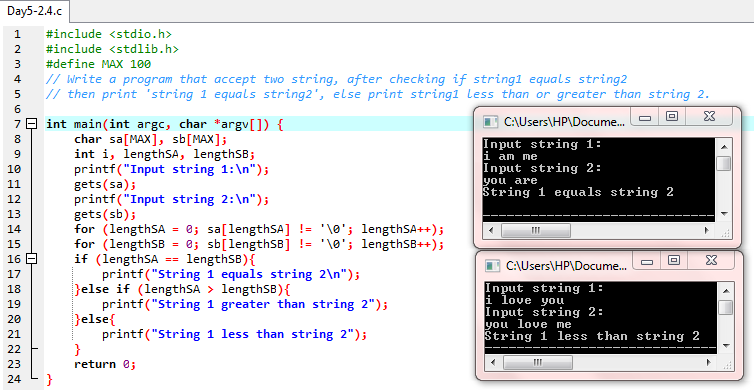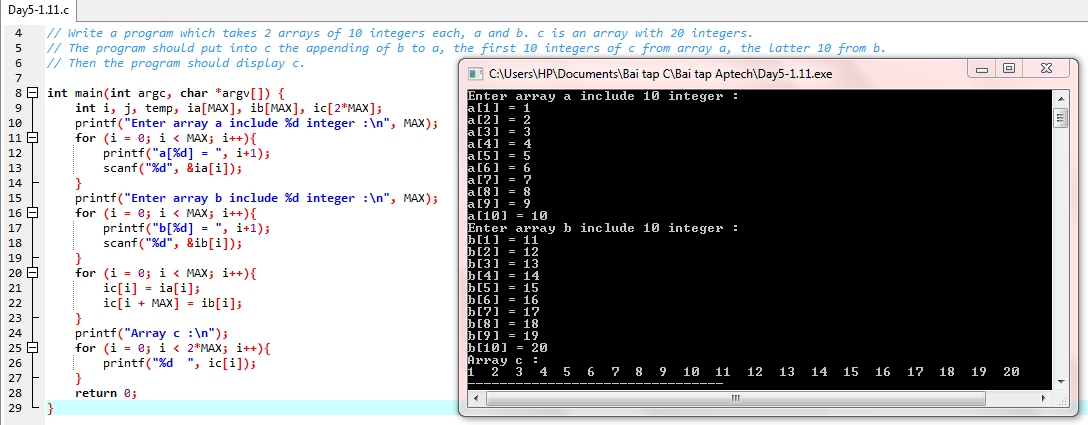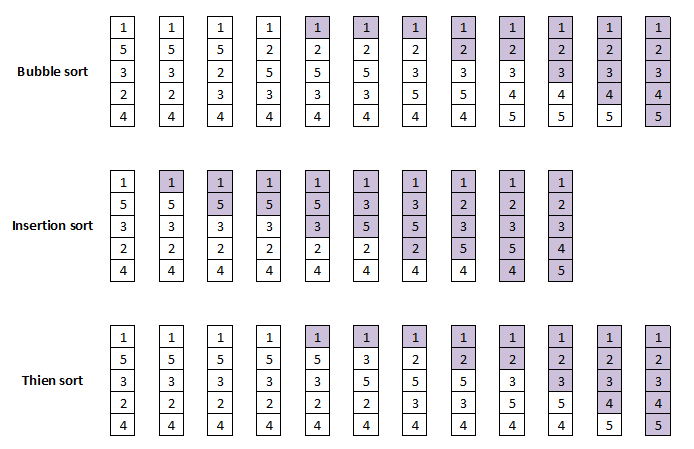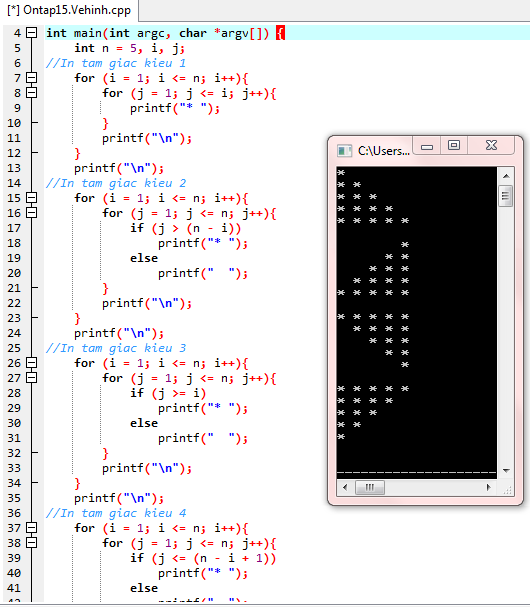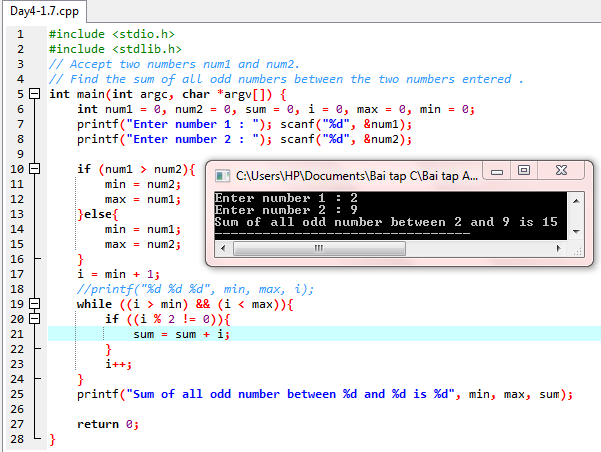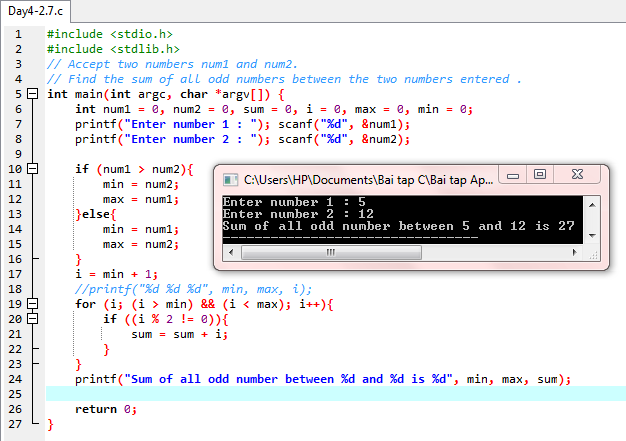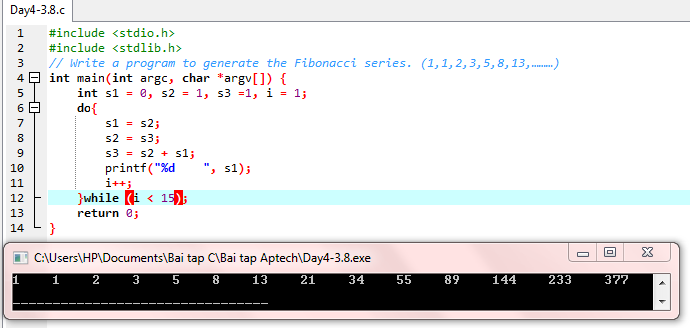Sunday, September 28, 2014
Tuesday, September 23, 2014
[LBC] Test day 1 - 2:
#include <stdio.h>
#include <stdlib.h>
#define MAX 12
int main(int argc, char *argv[]) {
float ftemp, months[12];
int i,j;
for (i = 0; i < 12; i++){
printf("Enter sales amount of month %d : ", i+1);
scanf("%f", &months[i]);
}
for (i = 11; i > 0; i--){
for (j = 11; j >= 12 - i; j--){
if (months[j] > months[j-1]){
ftemp = months[j-1];
months[j-1] = months[j];
months[j] = ftemp;
}
}
}
printf("After sort descending:\n");
for (i = 0; i < 12; i++){
printf("%.2f ", months[i]);
}
printf("\nTop 3 months with highest sales amount\n");
for (i = 0; i < 3; i++){
printf("%.2f \n", months[i]);
}
return 0;
}
[LBC] Day 7 -1: Excercise Struct
1. Write a C Program to store student data in a structure. The data should include student ID, name, course registered for, and year of joining. Write a function to display the details of students enrolled in a specified academic year. Write another function to locate and display the details of a student based on a specified student ID.
To do this,
a. Define the structure to store the student details.
b. Declare and initialize the structure with details of 10 students.
c. Set a loop to display a menu for the operations to be performed.
d. Accept the menu choice and invoke appropriate functions with the structure array as parameter.
e. In the function to display students for a year, accept the year. Set a loop to check each student’s enrollment year, and display if it matches. At the end, allow the user to specify another year.
In the function to locate student details, accept the student ID. Set a loop to check each student’s ID, and display if it matches. At the end, allow the user to specify another student ID.
2. Write a C program to store 5 lengths in a structure array. The lengths should be in the form of yards, feet and inches. Sort and display the lengths.
3. Write a C Program to store employee details in a structure array. The data should include emploee ID, name, salary, and date of joining. The date of joining should be stored in a structure. The program should perform the following operations based on a menu selection:
a. Increase the salaries according to the following rules:
Salary Range
|
Percentage increase
|
<= 2000
|
15%
|
> 2000 and <= 5000
|
10%
|
>5000
|
No increase
|
b. Display the details of employees who complete 10 years with the company.
4. Write a C program to implement an inventory system. Store the item number, name, rate and quantity on hand in a structure. Accept the details for five items into a structure array and display the item name and its total price. At the end, display the grand total value of the inventory.
5. Write a C program to store the names and scores of 5 students in a structure array. Sort the structure array in descending order of scores. Display the top 3 scores.
* Chú ý:
- Struct là một kiểu dữ liệu trong C, nó có thể chứa nhiều biến chứa nhiều biến có kiểu dữ liệu khác nhau, trong nó có thể có số nguyên, số thực, chuỗi và có thể chứa các kiểu struct khác nữa.
Cú pháp khai báo struct:
struct tên kiểu struct
{
kiểu dữ liệu_các thuộc tính của struct;
struct _ tên kiểu struct;
};
- Ta có thể tạo các mảng struct bằng cách khai báo : struct_ tên kiểu struct_ tên mảng struct[số lượng ];
- Khi khai báo kiểu struct trong hàm và nguyên mẫu hàm, chú ý phải khai báo đủ: struct_tên kiểu struct_tên struct[]
- Để tránh lỗi bộ nhớ đệm khi phải nhập một chuỗi sau một số thì khi nhập số ta lưu số đó vào một chuỗi tạm thời và dùng hàm atoi() để chuyển chuỗi tạm thời đó thành số và gán số đó vào struct.
Sunday, September 21, 2014
[LBC] Day 6 - 3: Excercise Function - Pass by references
1. Viết hàm truyền vào 2 số nguyên bất kỳ, thực hiện đổi chỗ 2 số đó
Nguyên mẫu hàm như sau:
void swap (int &number1, int &number2);
2. Viết hàm truyền vào một mảng số nguyên bất kỳ, sau đó đảo ngược mảng số nguyên đó
void reverse(int array[]);
3. Viết hàm truyền vào một mảng ký tự, và một ký tự bất kỳ, kiểm tra xem ký tự bất kỳ đó có nằm trong mảng không. Nếu có trả về số lần xuất hiện của ký tự đó, nếu không trả về -1
int countCharacter(char array[], char ch);
*Chú ý:
- Kiểu dữ liệu trả về của một hàm liên quan đến câu lệnh return, khi ta dùng return về giá trị nào thì giá trị trả về của hàm cũng sẽ có kiểu dữ liệu đó.
- Khi không có dữ liệu trả về thì kiểu dữ liệu của hàm là kiểu rỗng (void) và ta không có câu lệnh return trong hàm.
- Trong bài số 1, để đổi chỗ 2 số ta phải thay đổi địa chỉ chứa 2 số đó khi truyền tham số vào hàm, lý do phải truyền địa chỉ vì nếu chỉ truyền biến bình thường thì khi chương trình gọi hàm nó sẽ tạo ra các biến tạm thời và sẽ không thay đổi được biến thực tế khi truyền vào hàm.
[LBC] Day 6 - 2: Excercise Function - Pass by value
1. Write a function which accepts an integer value as input, and returns an integer which is the cube of that input
2. Write a function that accepts a char as input and returns true if the char is a digit from 0 to 9 or false if the character is not a digit from 0 to 9
3. Write a function named Smallest that takes three integer inputs and returns an integer that is the smallest of the three inputs. Write the prototype for the Smallest function. Write a program that gets 3 integers from a user and displays the smallest.
4. Write a function that, given a letter of the alphabet, returns true if the letter is a vowel (lower or uppercase) and returns false if the letter is not a vowel.
Khi khai báo mẫu nguyên hàm, trong phần kiểu dữ liệu của các biến số ta có thể chỉ khai báo kiểu dữ liệu chứ không cần phải viết cả tên các biến.
[LBC] Day 6 - 1: Excercise Function
1. Write a C program that accepts a number and square the number with the help of a function.
2. Write a C program to find the area and perimeter of a circle.
3. Write a C program to calculate the factorial of an integer
Function prototype: long factorial(int number);
4. Write a program with a function that takes two int parameters, adds them together, then returns the sum. The program should ask the user for two numbers, then call the function with the numbers as arguments, and tell the user the sum.
Function prototype: int calSum(int number1, int number2);
* Function:
Cấu trúc của function có dạng:
Kiểu dữ liệu trả về Tên hàm(kiểu dữ liệu và các biến số){Khối lệnh}
Để sử dụng hàm trong chương trình chính, trước tiên ta phải khai báo mẫu nguyên hàm có dạng:
Kiểu dữ liệu trả về Tên hàm(kiểu dữ liệu và các biến số);
Nguyên hàm sẽ có thêm dấu ";" đằng sau và không có khối lệnh.
Cấu trúc của function có dạng:
Kiểu dữ liệu trả về Tên hàm(kiểu dữ liệu và các biến số){Khối lệnh}
Để sử dụng hàm trong chương trình chính, trước tiên ta phải khai báo mẫu nguyên hàm có dạng:
Kiểu dữ liệu trả về Tên hàm(kiểu dữ liệu và các biến số);
Nguyên hàm sẽ có thêm dấu ";" đằng sau và không có khối lệnh.
Thursday, September 18, 2014
[LBC] Day 5 - 2: Character array
1. Write a program which prints the letters in a char array in reverse order. For
example, if the array contains {'c', 's', 'c', '2', '6', '1'}the output (to the terminal)
should be "162csc"
2. Write a program : declare a char array and the size of the array (of type char). This function counts the number of digit letters in the char array.
3. Write a program that counts the number of words in a string
4. Write a program that accept two string, after checking if string1 equals string2 then print 'string 1 equals string2', else print string1 less than or greater than string 2.
5. Write a function that scans a character array for the character - and replaces it with _
Chú ý:
- Với chuỗi ký tự ta cần nhớ ký tự cuối cùng mà chuỗi lưu trữ là ký tự NULL (\0) để máy tính xác định điểm kết thúc của chuỗi.
- Áp dụng lý thuyết trên ta có đk để duyệt toàn bộ các phần tử của chuỗi ký tự là i chạy tăng dần từ 0 cho đến khi nào array[i] = '\0' thì ta kết thúc việc duyệt chuỗi. Hoặc có thể cho i < sizeof(arr)/sizeof(char), cách này sẽ duyệt hết chuỗi và bỏ qua ptử cuối cùng của chuỗi là '\0'
- Sự khác nhau giữa mảng các ký tự và chuỗi ký tự là ở chỗ ptử cuối cùng của chuỗi ký tự là '\0', nếu k có ký tự NULL kết thúc đó thì chuỗi ký tự chỉ là mảng các ký tự riêng lẻ mà thôi.
- Phép gán arr = "Ha noi" sẽ báo lỗi do ta gán một chuỗi ký tự vào ptử đầu tiên của mảng ký tự là không đúng
Wednesday, September 17, 2014
[LBC] Day 5 - 1: Number array
1. Write a program that asks the user to type 10 integers of an array. The program must compute and write how many integers are greater than or equal to 10.
2. Write a program that asks the user to type 10 integers of an array. The program must output the largest element in the array, and the index at which that element was found.
3. Input values are accepted from the user into the array. Displays highest of the entered values. Prints average of values entered.
4. Write a program that accepts the following numbers in an array and reverses the array
5. Write a program to count the number of vowels in a line of text
6. Write a program that asks the user to type 10 integers of an array and an integer V. The program must search if V is in the array of 10 integers. The program writes "V is in the array" or "V is not in the array".
7. Write a program that asks the user to type 10 integers of an array and an integer value V. The program must search if the value V exists in the array and must remove the first occurrence of V, shifting each following element left and adding a zero at the end of the array. The program must then write the final array
8. Write a program that asks the user to type 10 integers of an array and an integer value V and an index value i between 0 and 9. The program must put the value V at the place i in the array, shifting each element right and dropping off the last element. The program must then write the final array
9. Write a program that asks the user to type 10 integers of an array. The program will then display either "the array is growing", "the array is decreasing", "the array is constant", or "the array is growing and decreasing."
10. Write a program that asks the user to type 10 integers of an array. The program will then sort the array in descending order and display it.
11. Write a program which takes 2 arrays of 10 integers each, a and b. c is an array with 20 integers. The program should put into c the appending of b to a, the first 10 integers of c from array a, the latter 10 from b. Then the program should display c.
* Chú ý:
Các thuật toán sắp xếp chuỗi số (vd: có 5 số theo chiều tăng dần)
- Bubble sort:
+ So sánh 2 ptử cuối cùng với nhau, nếu pt5 > pt4 thì đổi chỗ ngược lại thì giữ nguyên
+ So sánh pt4 với pt3 như trên
+ So sánh pt3 với pt2 như trên
+ So sánh pt2 với pt1 như trên
Sau bước này ta đã có pt1 là pt bé nhất, lặp lại toàn bộ quá trình trên cho đến khi tìm được pt bé nhất sau pt1 là pt2, lặp lại đến lần thứ 4 thì ta có được chuỗi 5 số sắp xếp theo chiều tăng dần
- Insertion sort:
+ Giả sử pt1 thuộc nhóm đã được sắp xếp
+ So sánh pt2 với pt1 nếu pt2 < pt1 thì đổi chỗ ngược lại giữ nguyên, pt1 và pt2 sau bước này thuộc nhóm đã được sắp xếp
+ So sánh pt3 với nhóm đã được sắp xếp gồm pt1, pt2. Chèn pt3 vào vị trí thích hợp của nó so với pt1 và pt2, sau bước này pt3 đã thuộc nhóm được sắp xếp
+ So sánh tiếp tục pt4 và pt5 tương tự như trên so với nhóm đã được sắp xếp, sau 4 lần so sánh ta được chuỗi có 5 pt sắp xếp theo chiều tăng dần
- Thien sort: đây là cách sắp xếp của mình, nó cũng tương tự bubble sort nhưng cách làm khác nhau
+ Bước 1: so sánh pt1 với 4 pt còn lại, nếu pt nào nhỏ hơn thì gán pt đó là pt1
+ Bước 2: so sánh pt2 với 3 pt còn lại, nếu pt nào nhỏ nhất thì gán pt đó là pt 2
+ Bước 3: so sánh pt3 với 2 pt còn lại, nếu pt nào nhỏ nhất thì gán pt đó là pt 3
+ Bước 4: so sánh pt4 với pt5 còn lại, nếu pt nào nhỏ nhất thì gán pt đó là pt 4
Sau 4 bước ta đã có được chuỗi 5 số sắp xếp theo chiều tăng dần.
Bảng so sánh giữa các cách sort:
Friday, September 12, 2014
[LBC] Ôn tập - Bài 15: Xếp hình đủ thể loại :))
Đây là dạng bài tập để thực hành vòng loop rất hay và thú vị:
Chú ý:
- Để làm dạng bài tập này ta phải dùng 2 vòng for lồng nhau, vòng for thứ nhất đại diện cho hàng, vòng for thứ 2 đại diện cho cột.
- Với mỗi loại hình cần in, ta phân tích hình thành nhiều hình nhỏ từ trên xuống có liên hệ tuyến tính với nhau và sử dụng các vòng for để vẽ từng hình nhỏ đó.
- Sử dụng các điều kiện của biến chạy hợp lý để in ra hình cần in.
Thursday, September 11, 2014
[LBC] Day 4 - 1,2,3: Using while loop, for loop and do..while loop do some exercises
1. Declare a variable which has the age of the person. Print the user’s name as many times as his age
* While loop:
* While loop:
2. The program displays even numbers from 1 to 30.
* While loop:
* While loop:
* For loop:
* Do...While loop:
4. The program will accept integers and display them until zero (0) is entered
* While loop:
* Do...While loop:
* While loop:
* For loop:
6. Write a program to print the series 100, 95 , 90, 85,………., 5.
* While loop:
* While loop:
* Do...While loop:
7. Accept two numbers num1 and num2. Find the sum of all odd numbers between the two
7. Accept two numbers num1 and num2. Find the sum of all odd numbers between the two
numbers entered :
* While loop:
* While loop:
8. Write a program to generate the Fibonacci series. (1,1,2,3,5,8,13,………)
* While loop:
* While loop:
* For loop:
* Do...While loop:
- Vòng for thường được sử dụng khi biết trước số lần lặp.
- While và Do...While thường sử dụng khi không biết trước số lần lặp.
- Do...While và While là tương đương nhưng Do ... While sử dụng khi cần thực hiện một khối lệnh nào đó trước khi xem nó có thỏa mãn đk hay không, có nghĩa nó đảm bảo khối lệnh đó được thực hiện ít nhất 1 lần.
Subscribe to:
Comments (Atom)



.PNG)
.PNG)
.PNG)

.PNG)
.PNG)
















